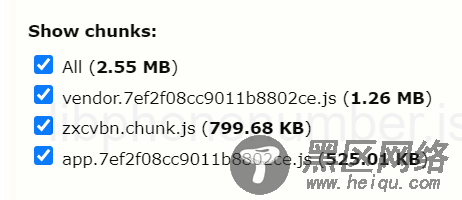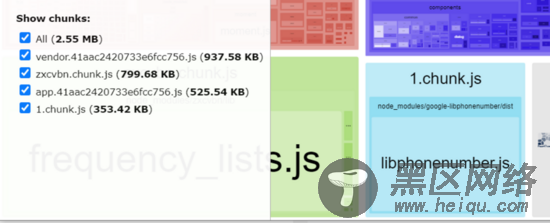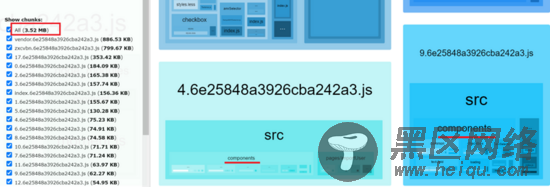最近项目里有个webpack版本较老的项目,由于升级和换框架暂时不被leader层接受o(╥﹏╥)o,只能在现有条件进行优化。
webpack3 + react16
webpack v3配置检查很明显项目的配置是从v1继承过来的,v1->v3的升级较为简单,参考官网https://webpack.js.org/migrate/3/即可。
loaders变为rules
不再支持链式写法的loader,json-loader不需要配置
UglifyJsPlugin插件需要自己开启minimize
使用webpack-bundle-analyzer构建包后,如图

问题非常明显:
除了zxcvbn这个较大的包被拆出来,代码就简单的打包为了vender和app,文件很大。
动态import拆分vender
分析vender的代码,某些大包,例如libphonenumber.js,使用场景不是很频繁,将它拆出来,当使用到相关特性时再请求。
参考react官方代码分割指南,
import { PhoneNumberUtil } from 'google-libphonenumber' function usePhoneNumberUtil(){ // 使用PhoneNumberUtil }
修改为动态 import() 方式,then和async/await都支持用来获取异步数据
const LibphonenumberModule = () => import('google-libphonenumber') function usePhoneNumberUtil(){ LibphonenumberModule().then({PhoneNumberUtil} => { // 使用PhoneNumberUtil }) }
当 Webpack 解析到该语法时,会自动进行代码分割。
修改后的效果:

libphonenumber.js(1.chunk.js)从vender中拆分出来了,并且在项目实际运行中,只有当进入usePhoneNumberUtil流程时,才会向服务器请求libphonenumber.js文件。
基于路由的代码分割React.lazy
参考react官方代码分割指南-基于路由的代码分割,。
拆分前示例:
import React from 'react'; import { Route, Switch } from 'react-router-dom'; const Home = import('./routes/Home'); const About = import('./routes/About'); const App = () => ( <Router> <Suspense fallback={<div>Loading...</div>}> <Switch> <Route exact path="https://www.jb51.net/" component={Home}/> <Route path="/about" component={About}/> </Switch> </Suspense> </Router> );
拆分后示例:
import React, { lazy } from 'react'; import { Route, Switch } from 'react-router-dom'; const Home = lazy(() => import('./routes/Home')); const About = lazy(() => import('./routes/About')); const App = () => ( // 路由配置不变 )
拆分后效果:
app.js按照路由被webpack自动拆分成了不同的文件,当切换路由时,才会拉取目标路由代码文件。

该段引用自 。
React.lazy 目前只支持默认导出(default exports)。如果你想被引入的模块使用命名导出(named exports),你可以创建一个中间模块,来重新导出为默认模块。这能保证 tree shaking 不会出错,并且不必引入不需要的组件。
// ManyComponents.js export const MyComponent = /* ... */; export const MyUnusedComponent = /* ... */;
// MyComponent.js export { MyComponent as default } from "./ManyComponents.js";
// MyApp.js import React, { lazy } from 'react'; const MyComponent = lazy(() => import("./MyComponent.js"));
自己实现AsyncComponentReact.lazy包裹的懒加载路由组件,必须要添加Suspense。如果不想强制使用,或者需要自由扩展lazy的实现,可以定义实现AsyncComponent,使用方式和lazy一样。
import AsyncComponent from './components/asyncComponent.js' const Home = AsyncComponent(() => import('./routes/Home')); const About = AsyncComponent(() => import('./routes/About'));
// async load component function AsyncComponent(getComponent) { return class AsyncComponent extends React.Component { static Component = null state = { Component: AsyncComponent.Component } componentDidMount() { if (!this.state.Component) { getComponent().then(({ default: Component }) => { AsyncComponent.Component = Component this.setState({ Component }) }) } } // component will be unmount componentWillUnmount() { // rewrite setState function, return nothing this.setState = () => { return } } render() { const { Component } = this.state if (Component) { return <Component {...this.props} /> } return null } } }
common业务代码拆分在完成基于路由的代码分割后,仔细看包的大小,发现包的总大小反而变大了,2.5M增加为了3.5M。

从webpack分析工具中看到,罪魁祸首就是每一个单独的路由代码中都单独打包了一份components、utils、locales一类的公共文件。
使用webapck的配置将common部分单独打包解决。
components文件合并导出示例是将components下的所有文件一起导出,其他文件同理
